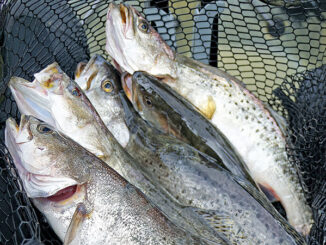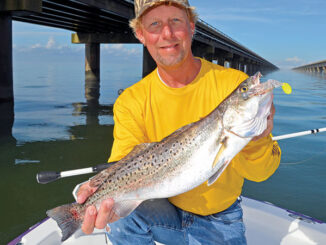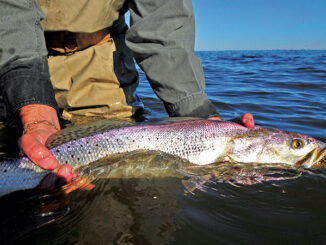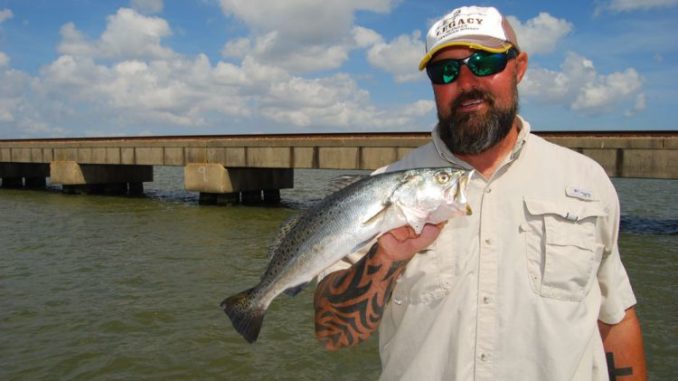
The World Series speckled trout run on eastern Lake Pontchartrain’s famed bridges is imminent, and just like in the Fall Classic, home runs and strike outs are both part of the game. Here’s how one guide keeps his clients swinging for the fences on the 5.
When October arrives, Mother Nature typically loosens her grip on the heat and humidity that have gripped the state since early summer, and teases us with a few tantalizing cool fronts that usher in the start of fall.
The Saints are back in full swing, and Major League Baseball culminates at the end of the month with another World Series. The gradual change of seasons coincides with the Fall Classic — and by coincidence, the end of the speckled trout spawn — which pushes fish from their saltier, deepwater summer haunts back inshore to coastal bays, lakes and marshes where they fatten up to ride out the winter.
For Lake Pontchartrain anglers, that means speckled trout will be heading back from where they came this spring, returning first into the Biloxi Marsh and Lake Borgne, then through the Rigolets and finally into the confines of the eastern end of the lake.
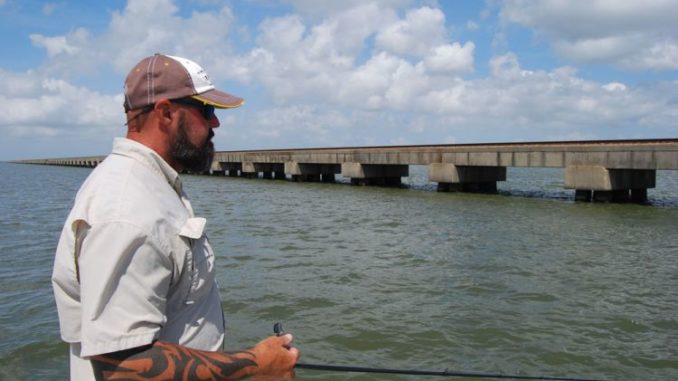
Some of the first structures they will encounter are the numerous bridges stacked up there: the I-10 Twin Span, the Highway 11 bridge and the Trestles. It’s a perfect storm for the trout — and all the anglers who look forward to the fall run every year.
“Those fish just make a big circle. In April or May, we’re fishing on the Trestles. Toward the end of May into June, we start fishing out in the Rigolets toward Lake Borgne,” explained Capt. Bubby Lamy, with In & Out Charters in Slidell. “As it gets further into the summer, now we’re way offshore. That’s the progression of where those fish are going if you’re looking for trout.
“But in September, the reverse happens. You’ll start seeing more fish closer in. They get on the bridges because there’s bait and easy accessibility, as far as sitting behind those pilings and being able to get food on incoming and falling tides.They’re passing by, and it will hold them there for a while because the water is at the right salinity for them for this time of year. They’re coming in to go fatten up.”
For anglers looking to catch numbers of fish in the fall, Lamy said the Trestles definitely leads the way, with the Highway 11 bridge known for fewer — but bigger — trout.
Many an angler’s dreams of catching a speck of a lifetime meet a watery grave when it comes to the unique vagaries of deepwater jigging in the lake, but Lamy shared some sage advice on how to hit a home run at the train bridge this fall.
The rules of the game
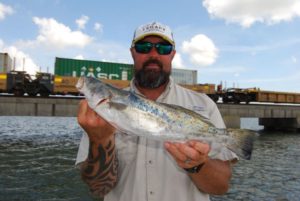
One important step, even for anglers familiar with Lake Pontchartrain, is understanding the unique nature of the train bridge, he said.
“Don’t get fixated on left or right of the pilings. That’s the trick — knowing that it’s not the same as the Causeway. On the Causeway, the fish are on those pilings, and the whole key is figuring out which side they’re on, because the fish will be staged the same way on every piling on that bridge,” Lamy said. “But the Trestles is a different game. If you try to play the same Causeway game, you’re going to go out there and say, ‘There was no fish there today.’ No, the fish were there.
“They were just 20 yards from the bridge — and you were casting right at the base of it. The game on the Trestles is distance from the track. If those fish are 10 yards off the bridge, and your boat is 10 yards away and you’re throwing to the bridge, you’re right on top of them — and you’ll never get a bite.”
Lamy favors fishing the west side of the Trestles on an incoming tide, especially when he’s using plastics, so the tide is coming at him. That way he’s throwing into the current, and his lure is mimicking the natural flow of baitfish.
He explained why distance from the bridge was key, and noted (with just a little hyperbole) how fishing pressure contributes to where trout might be holding on a given day.
“If you’re fishing on the west side, you’ve got 100,000 boats out there 10 or 20 feet off the pilings, and you’re casting at the pilings. While you’re doing that, there’s another 100,000 boats riding behind you back and forth and up and down, way off the bridge. So the fish that are by the bridge are getting pounded on with jigheads and all that, so they move further away from the bridge — and with people moving around, maybe even further away from the bridge,” he said. “So you have to figure it out, and that’s where most people get it wrong — because they just pound the pilings and never cast out the other side of the boat.”
Stay snag-free
Part of the attraction for specks holding on the train bridge is the mass of old pilings and wooden trestles located beneath the water’s surface, where baitfish seek safety and trout look to pick up a quick meal.
“I tell my clients there are two rules,” Lamy said with a chuckle. “Don’t cast over the tracks, and don’t cast underneath them. You don’t want to cast under the bridge between the pilings to the other side and then let it fall down. You’re going to get snagged every time.
“If you’re throwing a plastic and want to swim it back before it hits the bottom, that’s fine. But on a Carolina rig with live bait, you’re done every time you throw up underneath there.”
Rigging up
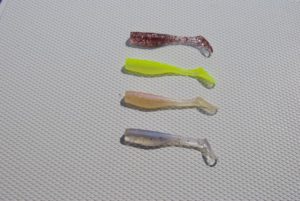
For Lamy, it’s pretty simple: A ⅜-ounce jighead with 17-pound mono line and whatever color Matrix Shad soft plastic lure you have confidence in.
“There’s a lot of guys who could care less what color their bait is, but I’m not one of those guys,” he said. “I’m big on color – if we’ve got different colors and you catch three fish on one and I don’t get a bite, I’m going to put on that same color. The colors can change.”
Here’s how the guide selects his lure color at the Trestles on a given day.
“Water clarity dictates what color range you should be in. If you’re in crystal clear water, you can throw the holy joely or the shrimp creole and get some good action. Magneto is one you you can use with clear or slightly tinted water. Ultraviolet is in-between, and in dirtier water, I love the lemon, the black with the chartreuse tail or the tiger bait.”
Feeling the bottom
It might sound easy enough to feel your jighead on the bottom, and if you fish in Lake Pontchartrain a lot, it probably is. But if you’re more accustomed to catching specks with live shrimp under a cork, deepwater jigging there while dealing with chop at the surface, a ripping current, boat position and lure presentation can get complicated pretty quickly.
“If you’re not feeling what it feels like to hit the bottom — if you don’t know the difference — then you need to have a heavier jighead until you figure out what the bottom feels like, because every time you’re casting, you want to know, ‘OK, that was the bottom.’ Pop, pop — nothing. Then pop — pop, and you get a strike before you timed it in your head that it should have landed back on the bottom. So that’s when you need to set the hook.”
Cracking the code
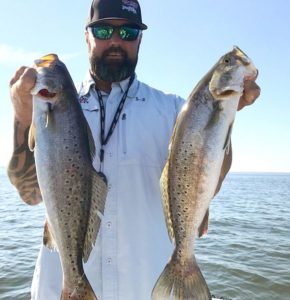
Lamy said how the fish want a lure presented also can change daily, and in addition to figuring out where specks are holding in relation to the Trestles, it’s the second piece of the puzzle to determine as you begin.
“Some days it’s dribbled in the dirt. Other days it’s an aggressive pop – pop – pop. Pop – pop – pop. Other days, you can have it in the dirt and lightly pop it up. But most of the time you’re getting that bite once you get the bait up, and it’s falling back down from whatever you’re doing,” he said. “Some days you can just let it set. Once it hits the bottom, wait a little while and then —boom, they’ll pick it up off the floor.
“You need to try all those things until you crack the code and say, ‘OK, we got it now.’”
Plan of attack
At almost 6 miles long, figuring out where to begin on the Trestles can be daunting. There’s no better substitute than time on the water, but Lamy shared a few tips on getting started.
“Typically the ends of the bridge will tell you where you should be fishing. If you go all the way to the south end and you don’t catch anything, but you pick up two or three on the north end, then you want to work from the north end to almost mid-lake and see how you do.”
In addition to the mile posts located on the actual bridge for the train operators, Lamy said many of the concrete pilings are numbered, as are the fire breaks that were put in place to prevent the old wooden structure from being completely destroyed in a single blaze.
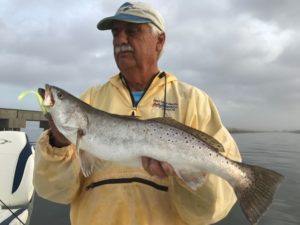
“Get reports from other people,” he said. “You don’t need to know the exact spot, but if somebody says, ‘I caught them around 174,’ now you can be in the area, and that eliminates the whole rest of the bridge.
“It helps you narrow things down.”
Spillway opening a home run?
Although Pontchartrain Basin anglers had to endure yet another opening of the Bonnet Carré Spillway earlier this spring — which poured copious amounts of fresh Mississippi River water into the lake — that typically means a serious trout run the following fall.
Chas Champagne, owner of Matrix Shad lures, said he’s hopeful anglers will reap the benefits after the most recent 22-day Spillway opening in March, which occurred to relieve pressure on levees in New Orleans and downriver because of an elevated Mississippi.
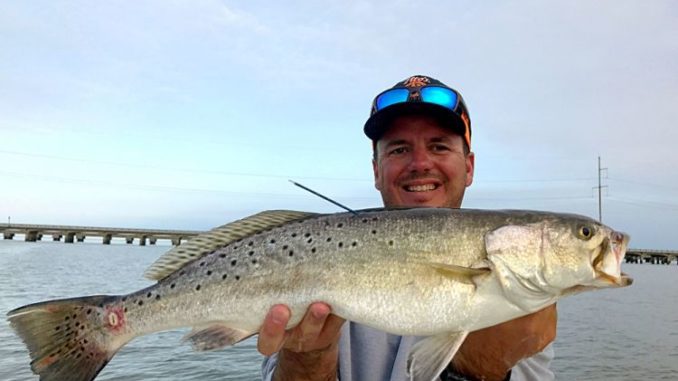
“It always seems like the fall is better after a Spillway year for whatever reason – providing nutrients, freshwater, bait … Who knows why, but it is,” Champagne said. “And it seems like you get more opportunity for a flounder run in the fall after a Spillway opening. October and November are the best for flounder. It usually happens on the west side of the Trestles, and they seem to favor the northern end.”
Another key for trout at the Trestles in October is the migration of white shrimp into the Pontchartrain Basin each fall, and Champagne said he already saw evidence of that happening last month.
“I’m already catching them in Lake Catherine, and that’s a good sign,” he said. “I talk to a lot of shrimpers, and it sounds like a good year … You also want to see a lot of pogies, and I’m seeing good amounts. So it should be a pretty good year.
“Only time will tell.”
